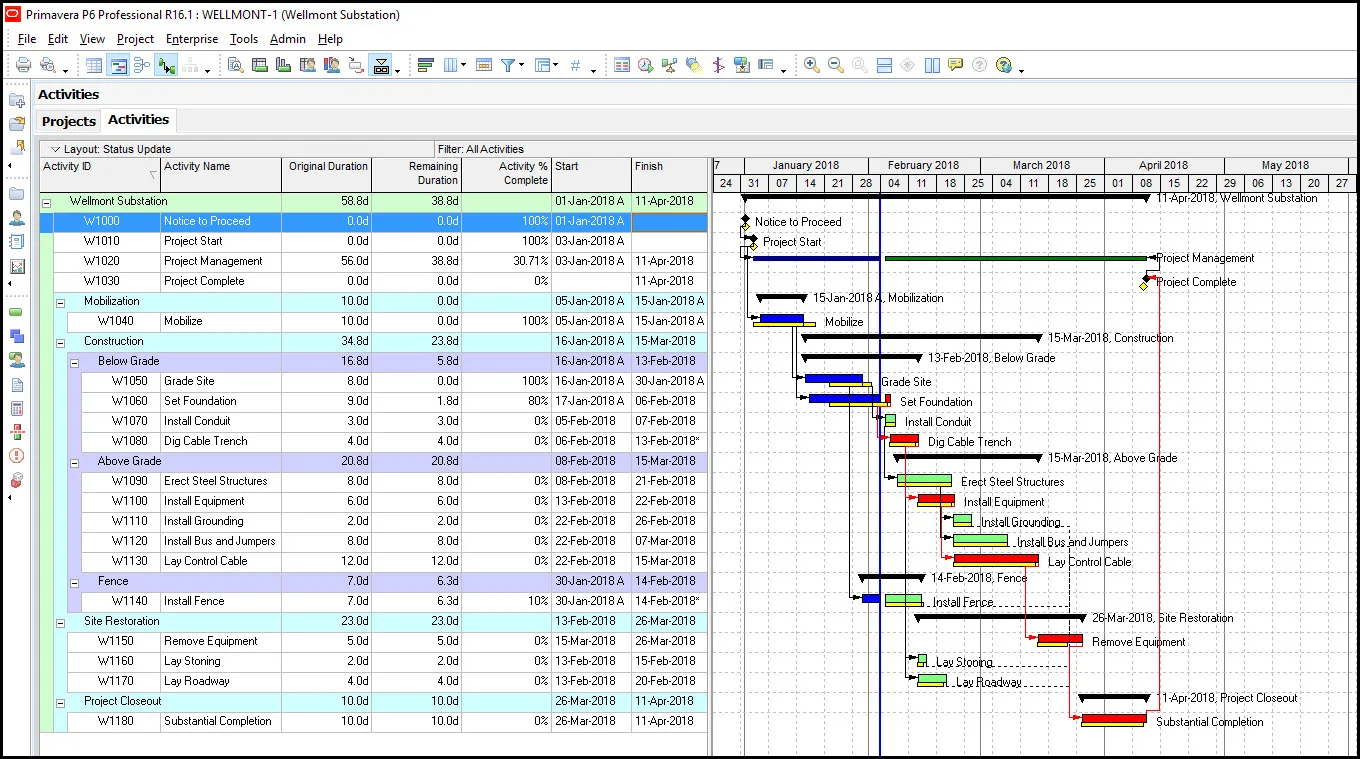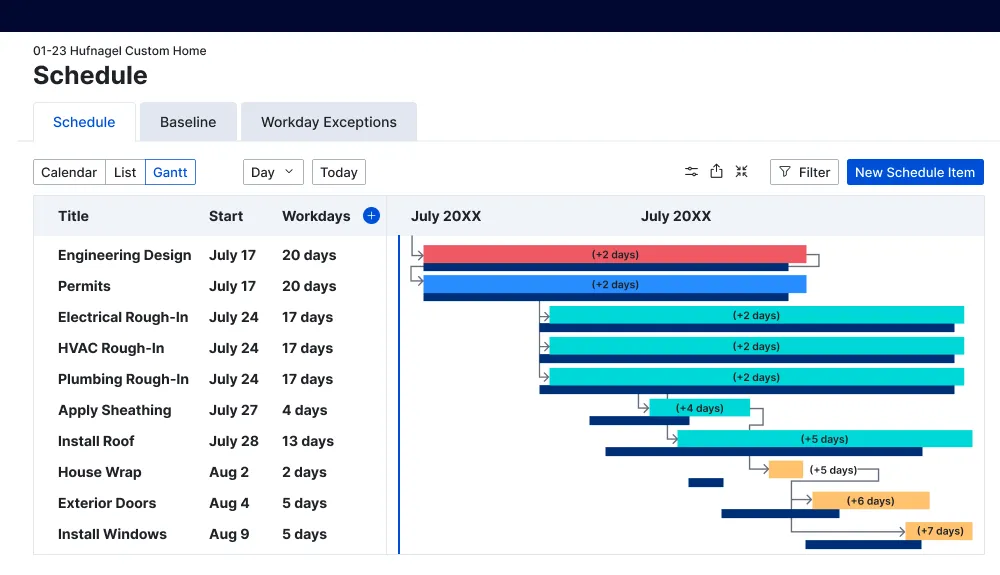.webp)
For construction owners and managers, effective project scheduling isn't just about meeting deadlines—it's about protecting your bottom line. Poor scheduling can trigger a cascade of financial impacts that extend far beyond simple project delays. Understanding these hidden costs is crucial for making informed decisions about scheduling tools and processes that can safeguard your profits.

When a construction project falls behind schedule, the immediate costs are obvious: overtime wages, extended equipment rentals, and delayed milestone payments. However, the real financial impact often lurks beneath the surface, creating ripple effects that can erode profitability across your entire operation.
The direct financial impacts of poor scheduling manifest in numerous ways. Labor costs surge when workers stand idle, waiting for predecessor tasks to be completed. Equipment rental periods stretch beyond their original scope, driving up rental fees and associated maintenance costs. When trying to make up for delays, companies often face premium prices for expedited materials. Missing contractual deadlines can trigger substantial liquidated damages, while extended project durations lead to increased insurance and bond expenses.
The indirect financial impacts can be even more severe and long-lasting. A history of delayed projects can significantly reduce your bonding capacity, limiting future opportunities for larger, more profitable jobs. Relationships with subcontractors and suppliers often suffer, leading to higher bids on future work or reluctance to work with your company altogether. Resources tied up in delayed projects represent lost opportunities for other profitable work.
When schedules compress to make up time, workforce productivity typically declines, creating a vicious cycle of further delays and costs. Insurance premiums may rise due to an adverse claims history, and perhaps most damagingly, your company's reputation in the market can suffer, affecting future bid opportunities and client relationships.
Implementing effective cost control through scheduling requires a comprehensive approach that integrates various essential practices. Here's a detailed look at the key strategies that construction owners should consider:

The foundation of effective scheduling lies in progressive planning, a methodical approach that begins with master scheduling and evolves into increasingly detailed plans. Start by developing a comprehensive master schedule that outlines the project's major milestones and phases.
From this foundation, create rolling three-week lookahead schedules that provide granular detail about upcoming work. This progressive approach allows you to identify and address potential conflicts early while maintaining the flexibility needed to adapt to changing site conditions and requirements.
The key advantage of this method is that it combines long-term strategic planning with short-term tactical execution, ensuring that daily operations align with overall project goals while remaining responsive to immediate needs.
Effective resource loading transforms a basic schedule into a powerful management tool. This process involves integrating detailed labor requirements, equipment needs, and material deliveries directly into your project timeline. When implementing resource loading, begin by analyzing historical data from similar projects to establish baseline requirements. Then, map out specific resource needs for each activity, considering factors such as crew sizes, equipment capabilities, and material quantities.
This comprehensive approach helps prevent resource conflicts before they occur and ensures that your schedule reflects real-world constraints. Pay particular attention to critical resources that could become bottlenecks, and develop contingency plans for peak demand periods. Resource loading also facilitates better cost tracking by linking specific resources to scheduled activities, allowing for more accurate budget forecasting and cost control.

Regular schedule analysis serves as an early warning system for potential delays and cost overruns. Establish a weekly schedule review process that goes beyond simple progress updates. During these reviews, compare actual progress against planned progress using earned value metrics to quantify any variances. Analyze your resource utilization rates to identify both underutilization and potential overallocation.
Pay special attention to critical path activities, as any delays in these tasks will directly impact your project completion date. Review the impact of approved change orders on your schedule and resource requirements, ensuring that any modifications are properly integrated into the master schedule.
Consider weather impacts and seasonal variations in productivity when analyzing schedule performance, and adjust future work plans accordingly. Document all findings and decisions made during these reviews to maintain a clear record of schedule evolution and support any potential delay claims.
Clear communication forms the backbone of successful schedule management. Develop a comprehensive communication framework that defines how schedule information will flow between all project stakeholders. This system should specify when and how schedule updates will be distributed, who needs to approve schedule changes, and what format will be used for different types of schedule information.
Establish regular schedule coordination meetings with key stakeholders, including subcontractors, suppliers, and client representatives. Create standardized reporting templates that clearly communicate schedule status and any potential issues. Implement a clear escalation process for schedule-related concerns, ensuring that problems are addressed at the appropriate level of management. Consider using visual management tools, such as color-coded schedule boards or digital dashboards, to make schedule information more accessible and actionable for field personnel.

Modern scheduling requires seamless integration of various technological tools and platforms. Develop a clear technology stack that supports your scheduling processes while remaining user-friendly for field personnel. This includes selecting appropriate scheduling software that can integrate with other project management tools, such as cost control systems, document management platforms, and field reporting applications. Ensure that your chosen technology solutions support mobile access for field teams while maintaining data security.
Implement regular technology training sessions to keep staff proficient with these tools and establish clear protocols for data entry and system updates. Create backup procedures for schedule data and establish contingency plans for technology failures to ensure continuity of scheduling operations.
Establish a comprehensive set of scheduling performance metrics that provide meaningful insights into project progress and efficiency. Track schedule variance at both the activity and project level, measuring both duration and cost impacts. Monitor resource utilization rates across different trades and equipment types to optimize allocation. Calculate and track cost performance index (CPI) and schedule performance index (SPI) to provide early warnings of potential issues. Measure milestone achievement rates and analyze the root causes of any delays. Use these metrics to identify trends and patterns that can inform future scheduling decisions and improve overall project performance.
This expanded approach to schedule management provides construction owners with a robust framework for controlling costs and maintaining project efficiency. By implementing these detailed practices, companies can significantly reduce the hidden costs associated with poor scheduling while improving their overall project delivery capability.
When evaluating investments in scheduling software and training, construction owners must consider both quantifiable returns and qualitative benefits that contribute to long-term success. A comprehensive ROI analysis reveals the substantial value that proper scheduling tools and processes bring to construction operations.

The measurable financial benefits of implementing robust scheduling systems are substantial and wide-reaching across various operational aspects. Companies that invest in comprehensive scheduling solutions typically see a significant reduction in overtime costs, generally achieving a 10-15% decrease through better resource planning and work coordination. This reduction alone often justifies the initial investment in scheduling technology and training.
Equipment utilization shows even more dramatic improvements, with most companies reporting a 15-20% increase in efficiency. This enhancement comes from better planning of equipment deployment, reduced standby time, and more effective coordination between multiple project sites. The financial impact becomes particularly significant for companies with extensive equipment fleets, where even small improvements in utilization rates can translate into substantial cost savings.
Material waste reduction represents another crucial area of tangible benefits. Through better planning and coordination of deliveries, companies typically achieve a 5-10% reduction in material waste. This improvement stems from more accurate quantity takeoffs, better-timed deliveries, and reduced storage damage. The cost savings extend beyond the direct material costs to include reduced disposal fees and handling costs.
Project delay reduction stands out as perhaps the most significant tangible benefit, with companies reporting a 20-30% improvement in meeting scheduled completion dates. This improvement directly impacts cash flow through earlier payment collection, reduced overhead costs, and decreased exposure to liquidated damages. The compounding effect of better schedule performance creates a positive cycle that enhances overall project profitability.
Administrative cost reduction represents a often-overlooked benefit, with companies achieving a 15-25% decrease in administrative overhead related to scheduling and project coordination. This efficiency comes from automated scheduling tools, reduced time spent resolving conflicts, and more streamlined communication processes. The savings in administrative costs often offset the ongoing subscription or maintenance costs of scheduling software within the first year of implementation.
Beyond the quantifiable returns, proper scheduling systems deliver significant intangible benefits that enhance company performance and market position. Project team collaboration sees marked improvement through better communication tools and clearer understanding of project timelines and dependencies. Teams develop stronger working relationships when everyone has access to clear, up-to-date schedule information, leading to more efficient problem-solving and reduced conflicts.
Client satisfaction levels typically increase substantially when projects run according to schedule. This improvement in client relationships often leads to repeat business opportunities and stronger referrals. Clients particularly value the transparency and professionalism that comes with well-maintained scheduling systems, seeing it as a mark of organizational maturity and reliability.
Risk management capabilities become significantly enhanced through better scheduling practices. Companies gain the ability to identify potential issues earlier, develop more effective contingency plans, and respond more quickly to emerging challenges. This proactive approach to risk management often prevents small issues from escalating into major problems, protecting both project timelines and profitability.
Competitive advantage in the marketplace strengthens as companies demonstrate consistent schedule performance and professional project management. This advantage becomes particularly valuable during bid evaluations, where past performance and project management capabilities often influence client decisions. Companies with strong scheduling practices can often command premium pricing based on their demonstrated ability to deliver projects reliably.
Subcontractor relationships improve markedly when schedules are well-maintained and communicated effectively. This enhancement leads to more competitive pricing from subcontractors, better resource availability, and more collaborative problem-solving during project execution. Strong subcontractor relationships become particularly valuable in tight labor markets, where reliable subcontractor partnerships can make the difference between project success and failure.
The combined impact of these tangible and intangible benefits creates substantial long-term value for construction companies. Organizations that invest in proper scheduling systems typically see overall project profit margins increase by 2-3 percentage points across their portfolio. This improvement comes from the cumulative effect of better resource utilization, reduced delays, and enhanced operational efficiency.
Beyond immediate project benefits, companies develop stronger organizational capabilities that support sustainable growth. The systematic approach to scheduling becomes part of the company's operational DNA, creating a foundation for consistent project delivery that supports expansion into larger, more complex projects. The investment in scheduling systems thus becomes a strategic asset that enables long-term business development and market positioning.
The ROI timeline for scheduling investments typically shows positive returns within 12-18 months, with benefits accelerating as teams become more proficient with the systems and processes. Companies that maintain consistent investment in scheduling tools and training continue to see improvements in performance metrics year over year, creating a sustainable competitive advantage in their market segments.
Modern scheduling software has become an essential tool for construction owners looking to minimize these hidden costs.
.webp)
Lumber Job Scheduling stands out as a comprehensive solution designed specifically for construction management needs. The platform excels at automating task creation and resource assignment, significantly reducing the administrative burden on project managers. Its seamless integration with time tracking systems ensures that scheduling decisions are based on real-time data about workforce availability and project progress. The intuitive drag-and-drop interface makes it accessible even to team members who may be less technically inclined, while robust real-time task progress monitoring keeps everyone aligned on project status.
For construction owners, Lumber Job Scheduling offers particular value through its ability to reduce administrative overhead through automation while improving resource utilization through better planning. The system's real-time updates minimize scheduling conflicts, while comprehensive project overview capabilities enhance visibility and control. Perhaps most importantly, it facilitates better communication with crews, ensuring that everyone stays informed and aligned with project goals.

Procore is another powerful option, offering a comprehensive project management platform beyond basic scheduling. Its advanced scheduling tools include critical path analysis capabilities, while strong collaboration features ensure all stakeholders stay informed. The mobile-friendly interface makes it particularly valuable for on-site use, and its extensive reporting capabilities help owners maintain clear visibility into project progress.

Primavera P6 serves as an enterprise-level solution ideal for larger organizations managing multiple complex projects. Its powerful resource optimization tools and risk analysis features make it particularly valuable for sophisticated scheduling needs. The platform excels at multi-project portfolio management and offers detailed cost tracking integration that helps owners maintain tight control over project finances.

Microsoft Project remains a popular choice, particularly for organizations already invested in the Microsoft ecosystem. Its familiar interface reduces the learning curve for many users, while strong dependency management and resource leveling capabilities provide the essential tools needed for effective scheduling. Integration with other Microsoft tools and customizable reporting make it a versatile option for many construction companies.

BuilderTREND rounds out the top options with its cloud-based approach and unique features like weather forecast integration. Its financial management tools and customer portal make it particularly valuable for residential builders, while comprehensive change order management helps maintain schedule integrity even as project scope evolves.
Begin implementing new scheduling tools on smaller projects to minimize risk and allow for learning opportunities.
Ensure all key personnel receive proper training on scheduling tools and best practices. The cost of training is minimal compared to the potential losses from poor scheduling.
Define clear metrics for measuring scheduling effectiveness:
The construction industry is moving toward more integrated scheduling solutions that incorporate:
For construction owners, the investment in proper scheduling tools and processes isn't just about avoiding delays—it's about protecting profitability and ensuring long-term success. By understanding the hidden costs of poor scheduling and implementing appropriate solutions like Lumber Job Scheduling, owners can significantly improve their project outcomes and financial performance.
The key is to view scheduling not as an administrative burden but as a strategic tool for business success. With the right combination of technology, training, and processes, construction owners can minimize the hidden costs of poor scheduling while maximizing their competitive advantage in an increasingly challenging market.